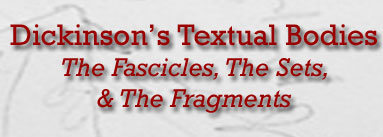

1.Consider the material body of the fascicles as the point of departure from which any investigation into Dickinson, critical or textual, will proceed. Describe the body of fascicle 1 using the conventions of standard bibliographical description to provide information about paper types and sizes and to express the patterns of sheets, half-sheets, and attachments. Indicate if leaves are conjugate or not and note formally any gaps--missing leaves, etc.--in the fascicles. Analyze Dickinson's use of and departure from the standard bibliographical codes of the codex book. Keep a list of the problems you encounter in applying the conventions of standard bibliographical description to Dickinson's fascicles. Speculate about Dickinson's decision to omit title pages, contents lists, and pagination from the fascicles.
2. Fascicle 2 has suffered mutilation. Research the history of the mutilation of this fascicle: When was the fascicle mutilated? What specific forms did the mutilation take? Who was responsible for the mutilations? What was the motive for the mutilations? How was the fascicle reconstructed, and what has been lost despite the reconstruction?
3. The introduction of variant readings into the fascicles in fascicle 5 is one of Dickinson's most radical textual moves. How many different ways does Dickinson display variant readings in the fascicles? What is significant about the changes in the displays? What other--further--signs of crisis are apparent in fascicles 5-12? (*Note: Although the first clearly identified variant appears in fascicle 5, Dickinson may have introduced variants in earlier fascicles. Look for possible variants in fascicles 1-4. ) How does Dickinson's use of variants challenge traditional definitions of the lyric poem?
4. By 1861--perhaps earlier--the internal structure of individual fascicles is becoming more complex. At the same time, there may be a corresponding increase in complexity in the relations between and among fascicles. Analyze the relations among the poems in a single fascicle. Which poems act as "strange attractors" within the fascicle? Are there poems that cannot be accounted for? Analyze the relations among two or more fascicles. You might well begin with Fascicles 15 and 16, which offer especially rich ground for an exploration of autonomy and intertextuality.
5. Fascicle 34, composed around 1863, contains some of Dickinson's most powerful poems on poetry ("My Life had stood - a Loaded Gun"; "Essential Oils - are wrung") and on the possibilities and limits of literary community ("Bereavement in their death to feel"; "These - saw Visions"; and "Strong Draughts of Their Refreshing Minds"). In what ways is fascicle 34 a scene of collaboration between Dickinson and the other poets she read? What is Dickinson's attitude towards literary community as it is expressed in this fascicle? *Compare these distant "acts" of collaboration with the nearer acts of collaboration with Susan Huntington Gilbert Dickinson.
6. How are we to read fascicle 40? Does an understanding of fascicle 40 depend upon an understanding of fascicles 1-39? In a late fragment Dickinson wrote, "Did you ever read one of her Poems backward, because the plunge from the front overturned you? I sometimes (often have, many times have -) A Something overtakes the Mind" (A 851). Is reading retrospective? Is the culmination of Dickinson's project in fascicle 40 coincident with its breakup? (See Dorothy Huff Oberhaus, Dickinson's Fascicles: Method and Meaning.)
Sets
1. In his "Introduction" to The Manuscript Books, R. W. Franklin notes: "When [Dickinson] stopped binding fascicle sheets about 1864, it was a conscious change rather than an action deferred and then forgotten. It had been anticipated as early as 1862, when she began leaving a few miscellaneous or leftover fascicle sheets unbound (Sets 1-4), whereas earlier such sheets had been bound, even if into a grouping of mixed paper or date" (MB I, xii). In what ways--if any--are these gatherings different from the earlier fascicles? Are there signs of "unbinding" even in the fascicles bound in the years when the fascicle structure is beginning to break apart?
2. Dickinson's attempts at bookmaking appear to have ended with the 1870s. Did Dickinson stop binding because her need for self-publication declined? Did she stop binding because the codex form was no longer her preferred mode of organizing her work? What is the status of bound work in comparison with unbound work?
Fragments
1. Nothing is less likely than that the late fragments constitute a unified collection of texts. On the contrary, the connections among them are at most transient. If, at times, it seems that one or two or even several act as "strange attractors," drawing near to one another, at other times the fragments appear as separate, antinomic texts, each one remote from the others, unassimilated and unassimilatable to a larger figure. Moreover, the collation of the significant printed sources of the fragments, which reveals an absence of critical consensus about what constitutes a fragment, seems to confirm their status as bibliographical "escapes," texts with no place in the body proper of Dickinson's work, in the codex book, or in the plot of literary history. Do the fragments, a mob of traces, some in verse, others in prose, if we prefer a distinction that is by this time in extremis, inaugurate a lyric non?discourse scattered in a series of singular, antinomic articulations and manifested finally as an absence d'oeuvre? How can this absence d'oeuvre be represented--and interpreted?
2. Dickinson's fragments which, temporally speaking, appear at a late moment in the trajectory of her writing, also appear at the outermost limits of her production, outside the bound collections of her poems. In what ways, however, may the impulse behind the production of fragments be related to the impulse behind the generation of variants; that is, in what ways do both the variants and the fragments announce a crisis at the extreme limit of a text, an oeuvre?